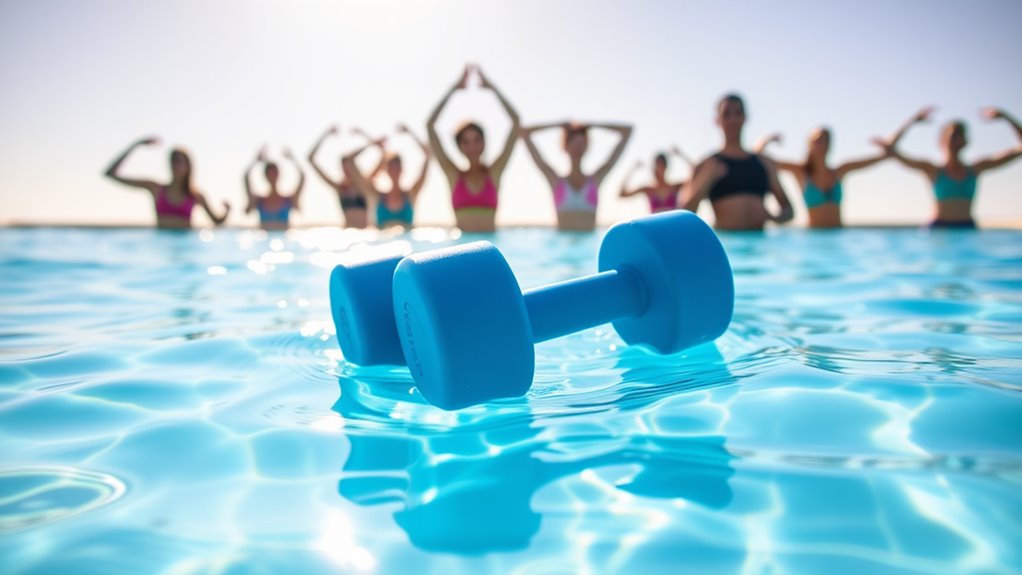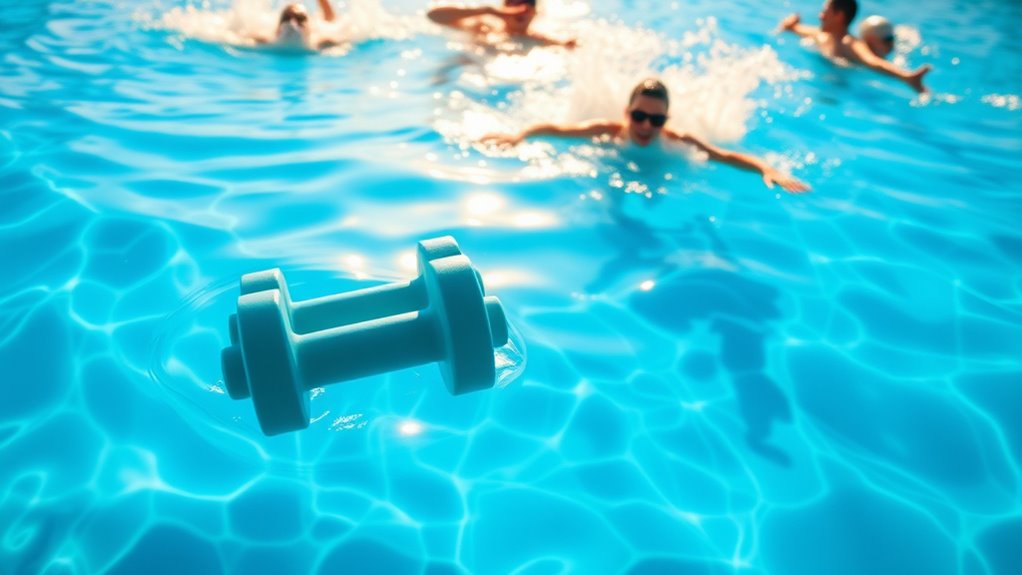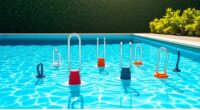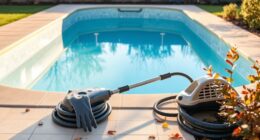Aquatic dumbbells transform your pool workouts by adding resistance that builds muscle and burns fat. They’re lightweight and made from buoyant materials, which engage both major and minor muscle groups while being gentle on your joints. This makes them perfect for all fitness levels, including recovery from injuries. Plus, they enhance core strength and stability. Curious about more ways they can boost your fitness routine? There’s a lot more to explore!
Key Takeaways
- Aquatic dumbbells combine fun and effectiveness, revolutionizing pool fitness with their buoyant materials and unique resistance profile.
- They engage both major and minor muscle groups, enhancing overall muscle tone and strength while providing a low-impact workout.
- Perfect for injury recovery, they reduce strain on joints, making them ideal for individuals with sensitivities or conditions like arthritis.
- A variety of exercises can be performed, targeting upper body strength and improving core engagement for better balance and stability.
- Easily accessible at local pools, they promote cardiovascular health while burning calories and building muscle mass.

Aquatic dumbbells are revolutionizing pool fitness by combining fun with effectiveness. You’ll find that these innovative tools, made from buoyant materials like EVA foam, provide a unique resistance profile while remaining lightweight outside the pool. Designed specifically for aquatic environments, they’re perfect for various exercises, including water aerobics and strength training. The buoyancy not only makes them enjoyable to use, but it also engages both major and minor muscle groups, enhancing your overall muscle tone and strength.
Aquatic dumbbells combine fun and effectiveness, engaging your muscles while providing a unique resistance workout in the pool.
When you work out with water dumbbells, the water’s resistance plays a critical role in building muscle and burning fat. This resistance helps target smaller muscle groups that traditional weights often overlook. You’ll appreciate how the combination of buoyancy and water resistance offers a low-impact yet intense workout. Your body will benefit from the supportive nature of the water, which helps with body positioning and stability, making it an ideal choice for individuals of all fitness levels, including children and seniors.
For those recovering from injuries or dealing with joint sensitivities, aquatic dumbbells provide a low-impact exercise option. These dumbbells make it easier for people who are overweight or have conditions like arthritis to engage in a gentle yet effective workout. The low-impact nature considerably reduces strain on your joints and limbs, making it a fantastic way to maintain physical health without excessive stress. Plus, these exercises are great for improving flexibility and range of motion.
You can perform a variety of exercises with water dumbbells, such as bicep curls, lateral raises, and chest presses. They’re especially effective for targeting upper body strength, helping you tone your arms, shoulders, and chest muscles. Using one dumbbell can create instability, enhancing your core strength and balance. This turbulence adds an extra challenge to your workout, making each session more engaging.
Engaging in water dumbbell exercises not only helps you burn calories but also builds muscle mass, which contributes to a higher resting metabolic rate. The combination of resistance and buoyancy provides a challenging yet efficient workout. Regular use of these dumbbells can improve your cardiovascular health through aerobic benefits, enhancing your overall fitness. Additionally, geometry concepts play a significant role in understanding the mechanics of resistance training in aquatic environments.
Easily accessible at local swimming pools, aquatic dumbbells are a convenient option that you won’t want to miss out on for your pool fitness journey.
Frequently Asked Questions
Can Aquatic Dumbbells Be Used in Open Water Swimming?
Using aquatic dumbbells in open water swimming can be challenging.
You’ll find that currents and waves may hinder your ability to perform exercises effectively. Plus, safety becomes a concern with floating objects in unpredictable conditions.
While you might want to incorporate resistance training, the controlled environment of a pool is ideal for maximizing your workout.
Instead, consider using swimming strokes or other methods that adapt better to open water conditions.
Are Aquatic Dumbbells Suitable for Rehabilitation Exercises?
Yes, aquatic dumbbells are definitely suitable for rehabilitation exercises.
They offer low-impact resistance, making them perfect for individuals recovering from injuries or surgeries. You’ll find that the buoyancy of water reduces stress on your joints, allowing for pain-free movement.
Plus, using these dumbbells can enhance muscle tone, improve flexibility, and support your overall recovery. They adapt well to various rehabilitation needs, helping you regain strength safely and effectively.
How Do I Choose the Right Weight for Aquatic Dumbbells?
Did you know that using weights as light as 2.5 pounds can greatly enhance your muscle strength in water?
To choose the right weight for aquatic dumbbells, start small to avoid overexertion, especially if you’re a beginner. Assess your shoulder strength, ensuring you select a weight that engages your muscles without straining your joints.
As you progress, gradually increase the weight to continue challenging yourself and improving your overall fitness.
Can Children Use Aquatic Dumbbells for Fitness?
Yes, children can use aquatic dumbbells for fitness, but supervision’s essential.
Make sure they understand proper usage to prevent injuries. Start with simple exercises like arm circles and water walking to build strength and confidence in a fun environment.
Keep in mind their comfort level in the water, and consult a doctor if they’ve health concerns.
With the right guidance, aquatic dumbbells can enhance their fitness journey effectively.
Do Aquatic Dumbbells Float or Sink in Water?
Aquatic dumbbells float in water due to their buoyant materials, which are designed to resist submersion.
When you try to push them underwater, you’ll feel the upward force working against you.
This floating characteristic means you’ll need to engage your muscles continuously to keep them submerged during your workout.
Conclusion
In the serene blue of the pool, you’ll find a world of strength waiting to be revealed. As you lift aquatic dumbbells, your muscles work against the gentle embrace of water, creating a unique blend of resistance and support. While the buoyancy lifts you, the weights challenge you, transforming every splash into a powerful workout. So, immerse yourself and experience the contrast: the calm of the water paired with the intensity of your effort. You’ve got this!









